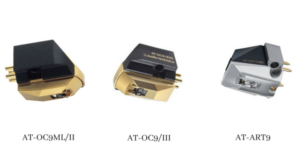Question: How do I determine which of the AT-OC9ML/II, AT-OC9/III and AT-ART9 premium phono cartridges is best for me?
Answer: In our Moving Coil (MC) lineup of phono cartridges, we have 3 premium models that look and spec very similar to one another. The focus of this article is to help you determine which is more suitable for your particular application and to point out the design differences and resulting advantages or disadvantages of each.

All models are based on Audio-Technica’s low-mass dual-coil vibration system mounted to an aluminum base and feature PCOCC (Pure Copper by Ohno Continuous Casting) coil windings for low-loss “transparent” signal transmission, along with an extremely rigid yet lightweight solid boron cantilever for accurate tracing of even the most intricate grooves. Styli are “nude” mounted, meaning the stylus and stylus shank are made from a single piece of diamond. Unlike a “bonded” stylus where the diamond tip is bonded to a shank of a different material, no bonding material is present to add unwanted mass or impede the transmission of the vibrations detected by the tip to the generator. A square stylus shank is inserted into a square laser-cut opening in the stylus cantilever, allowing for precise indexing. A stylus overhang gauge is provided with each model.
The AT-OC9ML/II cartridge is a variation of the popular original version, the AT-OC9, introduced in 1987. The OC9 series represents a significant achievement in manufacturing, with tolerances held to mere thousandths of an inch. Stringent quality control assures that these tolerances, as well as performance criteria, are maintained by every OC9 model. The AT-OC9ML/II pairs a MicroLine® diamond tip to a gold-plated solid boron cantilever. The MicroLine tip almost exactly duplicates the shape of the cutting stylus used to produce the original master disc from which a record is ultimately made. This enables it to track portions of a record’s groove other styli simply cannot reach, resulting in extremely accurate tracking of high-frequency passages and ruler-flat frequency response within the audible range. The unique multi-level shape of the tip wears more evenly, greatly extending record and stylus life. Gold plating the cantilever helps to dampen any resonance of the boron material, providing an exceptionally clear sound. In addition to the coil windings, the output terminal pins also feature PCOCC construction. The AT-OC9ML/II is a moderate compliance cartridge suitable for use with medium-mass tonearms (tonearms with an effective mass of 10 to 15 grams). Cartridge weight is 8.0 grams. The vertical tracking force requirement is the lowest between the three cartridges at 1.25 to 1.75 grams. The cartridge is noted for its outstanding clarity, transparency, precise stereo imaging, low distortion, low wear and high performance to cost ratio.
The AT-OC9/III draws from the basic design of the OC9ML/II. In order to track down and embody an even higher level of sound quality, however, it was necessary to review various components. By employing a high-energy neodymium magnet with a permendur yoke in place of the samarium cobalt magnet arrangement used in the ML/II, the magnetic field in the coil gap area is further strengthened. A special line contact tip permits the use of a higher compliance vibration system for a more refined sound while still providing excellent tracking and channel separation at moderate tracking forces. Next to the MicroLine stylus, the line contact stylus offers the optimum tip design for excellent high-frequency reproduction with minimum abrasion. The OC9/III adopts a reverse V-shaped formation for the left and right coils to reduce vibration mass as seen from the stylus tip and minimize unnecessary movement of the coils to further diminish any distortion. A lightweight VC mold holds the coils in place. Made from a hard synthetic resin containing potassium titanate to make it very strong and rigid, the mold provides an unprecedented reduction of unnecessary vibration. Like the ML/II, the coil windings and output terminal pins feature PCOCC construction. In addition, a high-quality PCOCC lead wire set is also provided. The AT-OC9/III is a high-compliance cartridge suitable for use with low-mass tonearms (tonearms with an effective mass of 5 to 10 grams). Cartridge weight is 8.0 grams. The tracking force requirement is 1.8 to 2.2 grams. The cartridge is noted for its ability to extract even the lowest level details, its clarity, low inner groove distortion and low record wear.
The AT-ART9 uses the same vibration system as the OC9/III, but the use of a larger-sized neodymium magnet and new cantilever dampener material increases the output level and improves transient response. A machined aluminum and hard plastic hybrid body reduces resonances for the clearest sound possible. A high-quality PCOCC lead set wire is provided. The AT-ART9 has a high-compliance suspension making it suitable for use with low-mass tonearms (tonearms with an effective mass of 5 to 10 grams). Cartridge weight is 8.5 grams. The tracking force requirement is 1.6 to 2.0 grams. The cartridge is known for its stunning detail, low inner groove distortion, low frequency reproduction and high performance-to-cost ratio.
A word about phono cartridge design types. Many serious audiophiles prefer moving coil designs, citing clarity and transparency of tone, better defined transients, precise stereo imaging and lower distortion as the reasons for their preferences. Please note that MC cartridges require preamps with special compatible inputs (MC phono inputs). The output level of an MC type cartridge is typically between 0.2 and 0.5 mV, therefore moving magnet (MM) phono inputs designed for cartridges producing around 3 to 5 mV cannot accommodate moving coil cartridges.
For additional information on compliance, please see our previous blog post on the topic. If you have any questions regarding cartridge selection, please feel free to contact the Audio Solutions Department.
















































































































































.webp)































